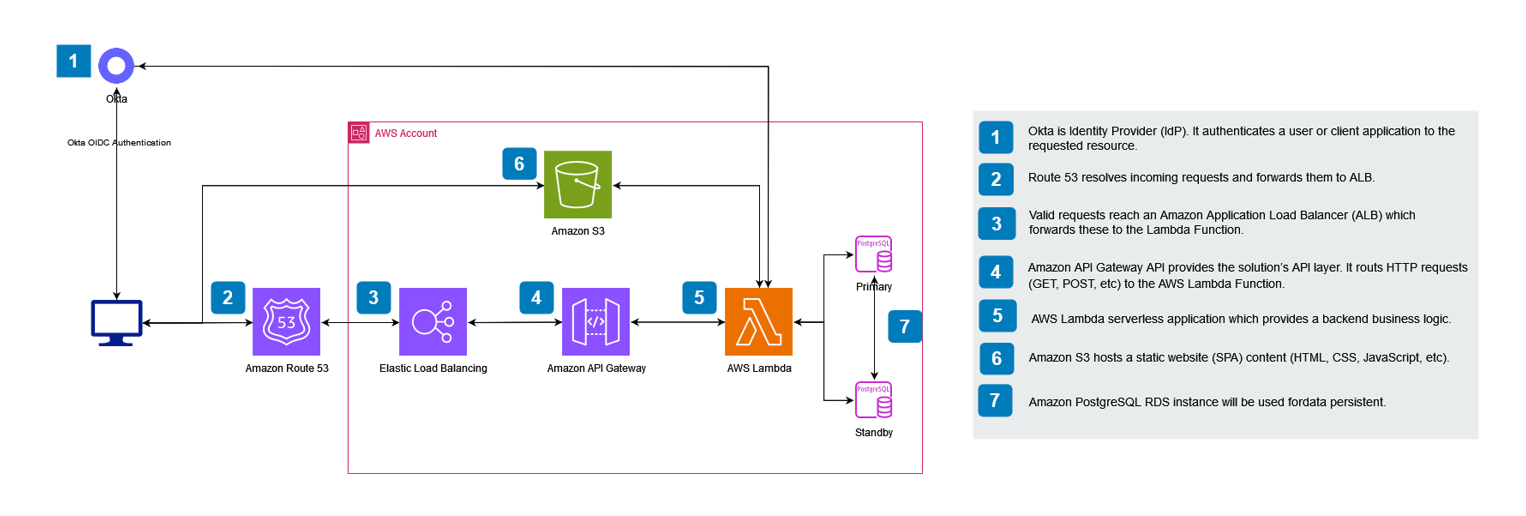Serverless Web Application Architecture Using AWS
Project Overview:
The customer, an American multinational manufacturing company sought to build a highly scalable, secure, and cost-effective web application. The company wanted a solution that could efficiently handle dynamic API-driven functionalities while ensuring a seamless user experience. Their core requirements included robust backend services, high availability, and low operational overhead.
Challenges:
The primary challenges included:
- Designing a solution capable of handling dynamic API requests with backend business logic.
- Ensuring data persistence and reliability.
- Managing scalability for both frontend static content and backend APIs with minimal operational complexity.
- Optimizing cost while maintaining high performance and security.
Proposed Solution & Architecture:
The project involved building a fully serverless web application architecture using Amazon Web Services (AWS) to deliver a highly scalable, secure, and cost-effective solution for a web-based event management platform. The architecture was designed to handle high traffic loads while ensuring fast response times and data integrity.
Architecture:
Architecture Components:
- Amazon Route 53:
Route 53 is used to resolve incoming DNS requests and route them to the Application Load Balancer (ALB), ensuring highly available and reliable domain name resolution for the web application. - Amazon S3:
Amazon S3 hosts the static website content, including HTML, CSS, and JavaScript for the Single Page Application (SPA). This setup ensures the application’s static assets are served quickly and efficiently to end-users. - Amazon API Gateway:
API Gateway provides the API layer for the application. It routes HTTP requests (GET, POST, etc.) to the appropriate AWS Lambda functions. API Gateway enforces request throttling to manage traffic and prevent overloading the backend systems, adhering to the event management service contract. - AWS Lambda:
AWS Lambda is used to handle the backend business logic in a fully serverless manner. Each Lambda function is granted least-privileged access using IAM roles, ensuring that it can only perform the operations required for its specific task. This enhances security and limits potential exposure. - Amazon RDS (PostgreSQL):
Amazon RDS (PostgreSQL) provides the persistent data storage layer. All event and user data are stored in a highly durable and scalable managed database service. - AWS X-Ray (Distributed Tracing):
AWS X-Ray is enabled for active tracing of requests across the architecture. This provides visibility into service interactions, enabling the development team to troubleshoot backend API issues and optimize performance using visual service maps and distributed tracing capabilities. - API Logging & Throttling:
Appropriate logging levels are set across the architecture, ensuring that necessary logs are captured without overwhelming log ingestion systems. Environment variables are used to dynamically control logging levels, enabling efficient debugging and monitoring. API Gateway is also configured to throttle operations based on predefined access patterns, preventing overuse and ensuring fair resource distribution.
Key Enhancements:
- Security:
Lambda functions are provisioned with the least-privileged access required, enhancing security and ensuring adherence to the principle of least privilege. - Performance Optimization:
API throttling mechanisms ensure that usage is controlled based on the event management service contract, preventing traffic spikes from overwhelming backend systems. - Cost Optimization:
The serverless architecture using AWS Lambda, API Gateway, and Amazon S3 ensures that costs scale based on actual usage. Unnecessary logging is minimized to reduce storage and ingestion costs. - Troubleshooting:
AWS X-Ray provides distributed tracing and service maps, allowing for quicker detection and resolution of performance bottlenecks or failures in the backend.
This architecture leverages AWS best practices to build a scalable, cost-efficient, and secure event management solution. The use of serverless technologies ensures that the platform is capable of handling variable traffic loads with minimal operational overhead.

